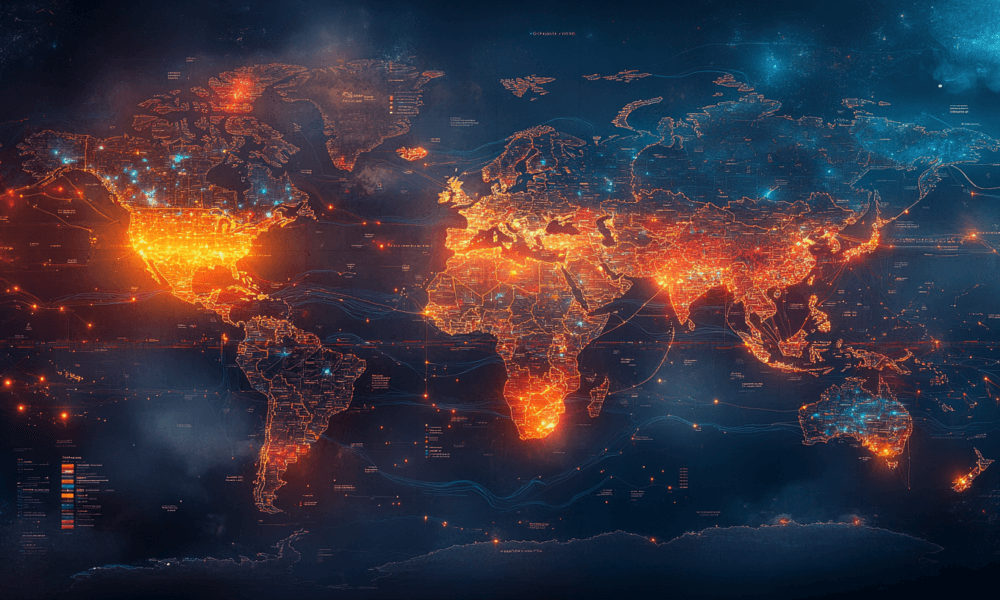Globalization in Flux: Navigating the Changing Landscape of International Trade and Cooperation
Globalization, the process of increasing interconnectedness between countries and cultures, has significantly shaped the world economy over the past few decades. From driving international trade to fostering economic growth and cultural exchange, globalization has played a pivotal role in creating a more interconnected global community. However, recent developments have put globalization in a state of flux. Shifting political dynamics, rising protectionism, supply chain disruptions, and the emergence of new technologies are reshaping the landscape of international trade and cooperation. In this article, we explore the changing nature of globalization, the challenges it faces, and how businesses and nations can adapt to this evolving environment.
The Evolution of Globalization
Globalization has its roots in the early days of exploration and trade, but it truly accelerated during the late 20th century with advances in technology, communication, and transportation. The rise of the internet, free trade agreements, and international cooperation led to unprecedented economic growth, transforming economies around the globe.
Key Phases of Globalization
- First Wave (19th Century): This period was marked by the growth of international trade, spurred by colonial expansion and the industrial revolution. Railways, steamships, and the gold standard facilitated the movement of goods and capital.
- Second Wave (1945-1990s): Following World War II, the establishment of institutions like the International Monetary Fund (IMF), World Bank, and the General Agreement on Tariffs and Trade (GATT) paved the way for economic cooperation. The Cold War also saw the world divided into two economic blocs.
- Third Wave (1990s-Present): The end of the Cold War, the rise of the internet, and the formation of the World Trade Organization (WTO) accelerated globalization. The integration of China and India into the world economy further fueled global trade.
Challenges Facing Globalization Today
In recent years, the process of globalization has faced significant headwinds. Several challenges are contributing to the changing landscape of international trade and cooperation.
1. Rise of Protectionism
Protectionism, characterized by countries implementing tariffs, quotas, and other trade barriers, has been on the rise in recent years. The United States, under the Trump administration, implemented tariffs on Chinese goods, which led to a trade war between the world’s two largest economies. Other countries have also adopted protectionist measures to shield domestic industries from foreign competition.
- Impact on Global Trade: Protectionist policies disrupt global supply chains, increase the cost of goods, and hinder economic growth. The trend towards protectionism has raised concerns about the future of free trade and multilateral cooperation.
- Regional Trade Agreements: In response to rising protectionism, countries are increasingly focusing on regional trade agreements, such as the Comprehensive and Progressive Agreement for Trans-Pacific Partnership (CPTPP) and the Regional Comprehensive Economic Partnership (RCEP).
2. Supply Chain Disruptions
The COVID-19 pandemic exposed the vulnerabilities of global supply chains, leading to shortages of essential goods, delays in production, and increased costs. The pandemic highlighted the risks of over-reliance on a few key suppliers, particularly in sectors like pharmaceuticals, electronics, and automotive.
- Diversification of Supply Chains: To mitigate these risks, companies are diversifying their supply chains by nearshoring (relocating production closer to home) or reshoring (bringing production back to the home country). This shift is expected to create more resilient supply chains but may increase production costs.
- Just-in-Time vs. Just-in-Case: The traditional “just-in-time” supply chain model, which minimizes inventory to reduce costs, is being reconsidered in favor of a “just-in-case” model that prioritizes resilience and the ability to handle disruptions.
3. Technological Disruption
Technological advancements, particularly in automation, artificial intelligence (AI), and digitalization, are reshaping the nature of work and international trade. While these technologies have the potential to increase efficiency and productivity, they also pose challenges for workers and economies.
- Impact on Jobs: Automation and AI are changing the demand for labor, leading to job displacement in some industries while creating new opportunities in others. Countries and companies must invest in workforce reskilling to adapt to these changes.
- Digital Trade: The rise of e-commerce and digital trade is transforming how goods and services are bought and sold across borders. Digital platforms are enabling small businesses to access global markets, but they also raise questions about data privacy, taxation, and regulation.
4. Geopolitical Tensions
Geopolitical tensions, particularly between major powers like the United States, China, and Russia, are having a significant impact on globalization. Trade disputes, sanctions, and diplomatic conflicts are creating uncertainty in international markets and affecting global supply chains.
- US-China Rivalry: The ongoing rivalry between the US and China has led to restrictions on technology transfers, increased tariffs, and efforts by both countries to reduce their economic interdependence. This decoupling could lead to a more fragmented global economy.
- Sanctions and Trade Barriers: Sanctions imposed on countries like Russia and Iran have further complicated international trade, making it difficult for companies to operate in these regions.
Opportunities for International Cooperation
Despite the challenges facing globalization, there are also opportunities for international cooperation and collaboration. Global challenges, such as climate change and the COVID-19 pandemic, have underscored the importance of working together to address common issues.
1. Climate Change and Sustainability
Climate change is a global challenge that requires international cooperation. Countries are increasingly working together to reduce greenhouse gas emissions, transition to renewable energy, and develop sustainable practices.
- Paris Agreement: The Paris Agreement is a landmark international treaty aimed at combating climate change by limiting global warming to below 2 degrees Celsius. Countries are setting ambitious targets to reduce emissions and transition to cleaner energy sources.
- Green Trade: International trade is also being leveraged to promote sustainability. For example, the European Union’s Green Deal includes measures to ensure that imported goods meet environmental standards.
2. Digital Cooperation
The digital transformation of the global economy presents opportunities for countries to work together to establish standards, regulations, and frameworks for digital trade and data governance.
- Data Privacy and Security: With the rise of digital trade, data privacy and security have become critical issues. International cooperation is needed to establish data protection standards that ensure privacy while facilitating the flow of data across borders.
- Digital Inclusion: International organizations, governments, and tech companies are working to bridge the digital divide by providing access to technology and digital skills training in underserved regions.
3. Health and Pandemic Response
The COVID-19 pandemic highlighted the need for international cooperation in health and pandemic response. The rapid development and distribution of vaccines were made possible through global partnerships and knowledge sharing.
- COVAX Initiative: The COVAX initiative, led by the World Health Organization (WHO), aimed to provide equitable access to COVID-19 vaccines for all countries, regardless of their economic status.
- Strengthening Global Health Systems: Countries are now focusing on strengthening their health systems and enhancing global health security to better prepare for future pandemics.
Adapting to the New Landscape of Globalization
The changing landscape of globalization presents both challenges and opportunities for businesses, governments, and individuals. To navigate this evolving environment, it is crucial to adapt and find new ways to thrive in an increasingly interconnected world.
1. Embracing Regionalization
With the rise of protectionism and geopolitical tensions, businesses are increasingly focusing on regional markets and supply chains. Regionalization allows companies to mitigate risks, reduce transportation costs, and respond more quickly to changes in demand.
- Regional Trade Agreements: Businesses should leverage regional trade agreements to expand their market reach and reduce reliance on distant suppliers.
- Local Partnerships: Building partnerships with local suppliers and distributors can help companies reduce their exposure to global disruptions.
2. Investing in Technology and Innovation
Technological advancements are driving the next phase of globalization, and companies must invest in technology to remain competitive. Automation, AI, and digital platforms can help businesses streamline operations, reach new customers, and improve efficiency.
- Supply Chain Resilience: Technologies like blockchain and AI can improve supply chain transparency and resilience, helping companies respond to disruptions more effectively.
- E-Commerce Expansion: Businesses should expand their digital presence and leverage e-commerce platforms to reach global customers, particularly as digital trade continues to grow.
3. Developing a Skilled Workforce
As the nature of work changes, investing in workforce development is essential. Governments and businesses should work together to provide education, training, and reskilling opportunities to ensure that workers can thrive in the new global economy.
- Reskilling Initiatives: Governments and companies should invest in reskilling initiatives to help workers adapt to technological changes and find new opportunities in emerging industries.
- Lifelong Learning: Promoting a culture of lifelong learning can help individuals stay competitive and resilient in a rapidly changing job market.

Conclusion
Globalization is in a state of flux, driven by shifting political dynamics, technological advancements, and economic disruptions. While the challenges are significant, there are also opportunities for international cooperation, regionalization, and technological innovation that can help shape a more resilient and inclusive global economy. By adapting to the changing landscape of globalization, businesses, governments, and individuals can continue to thrive in an interconnected world.
Navigating this new era of globalization requires flexibility, innovation, and collaboration. By embracing regionalization, investing in technology, and developing




No Comment! Be the first one.